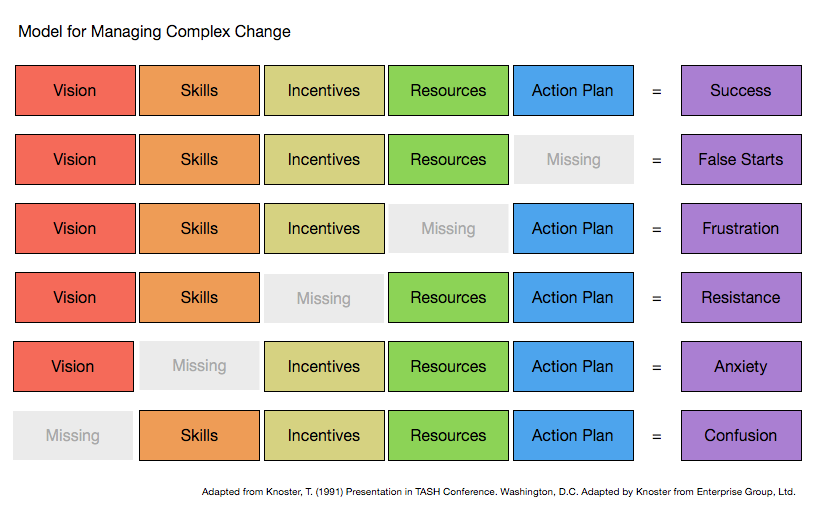Xavier Fernandes, Analytics Director at Metapraxis, talks about how FP&A teams are using AI to drive...
 Back in 2000 there was an article by Knoster, Villa and Thousand titled "A framework for thinking about Systems Change".
Back in 2000 there was an article by Knoster, Villa and Thousand titled "A framework for thinking about Systems Change".
The below article focuses on the framework that could be used by financial planning and analysis (FP&A) to help organisations navigate through a complex change.
Why change management is relevant for FP&A?
Change is the new normal. However, it is believed that most complex changes fail to deliver the promised benefits.
Finance needs to ensure that complex change is managed well since the finance department is responsible for allocating financial resources to the right initiatives and providing assurance on the outcomes.
How to guarantee a successful change process?
Knoster, Villa and Thousand summarized their findings in the diagram below.
5 critical elements need to be in place to guarantee a successful change. If any of the elements is missing, it could lead to certain problems that can be summarized by one word that describes how it would feel to be in such a situation. For example, one can feel either confused, anxious or frustrated depending on the element that is missing.

What are the five elements for successful change?
Vision: Why do we need to change?
Human beings want to understand the why and if there is a lack of vision, it can be confusing. It can even lead to resentment issues because people may feel that something is being hidden. In such situations, they tend to make up their own picture to fill in the gaps. This can lead to a lack of shared alignment in the process of managing change.
What can FP&A do? In my experience, usually leadership focuses on the technical side of change rather than on the emotional side. FP&A should insist on the need for a clear vision that helps articulate the why in an emotionally resonant manner.
Skills: Can we do the project?
Does the project team have the necessary skills to manage the change in a confident manner? If not or if they do not think so, they will have to deal with confidence issues and axiety when working on different tasks. Moreover, they will also project these anxieties to the wider organization. This can create a vicious circle and hinder the project implementation.
What can FP&A do? FP&A can ask the right questions regarding the required skill set. For example, if the project requires some specific skills, this should be highlighted. FP&A can also make sure that the organization is not taking unnecessary short cuts in an attempt to acquire or free up these skills.
Incentives: What's in it for us?
If nothing is offered in return, there is likely to be resistance from the people who are needed to make change happen. This is true for both project managers and those employees who are impacted by the change.
What can FP&A do? FP&A needs to ask questions about whether any existing incentives need to be added to or adjusted. The cost of any incentives should be factored into the Business Case in advance.
Resources: How to prepare the team?
Even if everything is in place, it can be tought to actively lead, manage and coordinate the project team. Both inefficiency and ineffectiveness of resource utilisation can lead to initial energy and momentum being sapped. If sufficient time is not carved out and no easy tools are used in the project, it can lead to frustration and even disengagement.
What can FP&A do? Working with and supporting the Project Manager can help ensure that team interactions are of good quality. FP&A can also monitor team members who might begin to struggle to be present or stick to the commitments.
Action Plan: Are we ready?
If there is no plan that provides a good overview of the first important steps, there is likely to be either too much communication that keeps going around in circles or radio silence. Both will lead to a sense of either paralysis or running without getting anywhere.
Complex change by necessity is more uncertain, so in this case the planning needs to go hand in hand with feedback, learning and adaptation. The team has to feel there is a smart plan.
What can FP&A do? FP&A should not allow any business case to be signed off (at the relevant stage gate) unless there is a clear plan that is also discussed and approved.
In Summary
This article has illustrated the change framework that can be a simple yet effective way to understand complex change. By ensuring effective investments, FP&A can play a defining role in increasing the chances of having all required elements in place for the project.
The article was first published in Unit 4 Prevero Blog
Subscribe to
FP&A Trends Digest

We will regularly update you on the latest trends and developments in FP&A. Take the opportunity to have articles written by finance thought leaders delivered directly to your inbox; watch compelling webinars; connect with like-minded professionals; and become a part of our global community.



